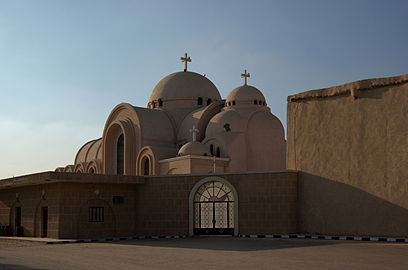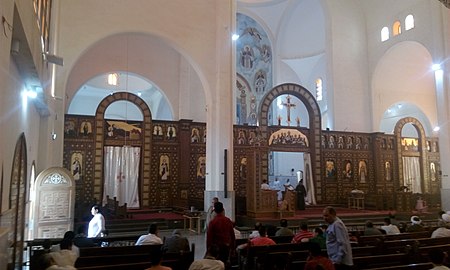Monastery of Saint Pishoy
- Machine translation, like DeepL or Google Translate, is a useful starting point for translations, but translators must revise errors as necessary and confirm that the translation is accurate, rather than simply copy-pasting machine-translated text into the English Wikipedia.
- Do not translate text that appears unreliable or low-quality. If possible, verify the text with references provided in the foreign-language article.
- You must provide copyright attribution in the edit summary accompanying your translation by providing an interlanguage link to the source of your translation. A model attribution edit summary is
Content in this edit is translated from the existing Arabic Wikipedia article at [[:ar:دير الأنبا بيشوي]]; see its history for attribution. - You may also add the template
{{Translated|ar|دير الأنبا بيشوي}}to the talk page. - For more guidance, see Wikipedia:Translation.
The Monastery of Saint Pishoy (also spelled Bishoy, Pshoi, or Bishoi[1]) in Wadi El Natrun, Beheira Governorate, Egypt, is the most famous monastery of the Coptic Orthodox Church of Alexandria named after Pishoy. It is the easternmost of the four current monasteries of Wadi el Natrun.
Foundation and ancient history
Pishoy founded this monastery in the fourth century.[2] On December 13, 841 (4 Koiak, 557 AM), Pope Joseph I of Alexandria fulfilled Pishoy's wishes and moved his body as well as that of Paul of Tammah to this monastery, both of which were originally interred at the Monastery of Pishoy in Deir el-Bersha. Today, the two bodies lie in the main church of the monastery.
Modern history
Today, the Monastery of Saint Pishoy contains the relics of Pishoy, Paul of Tammah, and relics of other saints. Eyewitnesses recount that the body of Pishoy remains incorrupt. Pope Shenouda III of Alexandria is also interred there.
The monastery has five churches, the main one being named after Pishoy. The other churches are named after Mary, Abaskhiron the Soldier, Saint George, and the archangel Michael. The monastery is surrounded by a keep, which was built in the fifth century to protect the monastery against the attacks by Berbers. An initial castle was built early in the twentieth century, but was later replaced by a four-storied castle built by Pope Shenouda III. In addition, the monastery contains a well known as the Well of the Martyrs. Coptic tradition says the Berbers washed their swords in this well after having killed the Forty-Nine Martyrs of Scetis and subsequently threw their bodies in the well before Christians retrieved the bodies and buried them in the nearby Monastery of Saint Macarius the Great.
Under Shenouda III, Pope of the Coptic Orthodox Church of Alexandria from 1971 to 2012, new land around the monastery was purchased and developed. Poultry, cattle breeding and dairy facilities were developed. Ancient buildings and churches were restored, and cells for monks, retreat houses, a papal residence, annexes for a reception area, an auditorium, conference rooms, fences and gates were built. Shenouda III was buried here after his death in March 2012. Bishop Sarabamon the former abbot of the monastery is also buried here.
Popes from the Monastery of St. Pishoy
- Pope Gabriel VIII (1525–1570)
- Pope Macarius III (1942–1945)
- Pope Tawadros II (2012–present)
Abbot
Aghapius is the Bishop and Abbot of the Monastery of Saint Pishoy.[3]
Other monasteries named after Saint Pishoy
- The Monastery of Saint Pishoy at Deir El Barsha, near Mallawi
- The Monastery of Saint Pishoy at Armant, east of Armant
Other monasteries of Wadi el Natrun ("Scete")
Gallery
-

-

-
-
-
 Cathedral of Saint Pishoy
Cathedral of Saint Pishoy -
 Interior of the cathedral
Interior of the cathedral
See also
References
External links
- Official Website of the Monastery of Saint Pishoy (in Arabic)
- v
- t
- e


- Nitria
- Kellia
- Wadi El Natrun
- Paromeos Monastery
- Monastery of Saint Macarius the Great
- Monastery of Saint Pishoy
- Syrian Monastery
- Category
- Christianity in Egypt
- Monasteries by country
30°19′09″N 30°21′36″E / 30.3192°N 30.3601°E / 30.3192; 30.3601

















